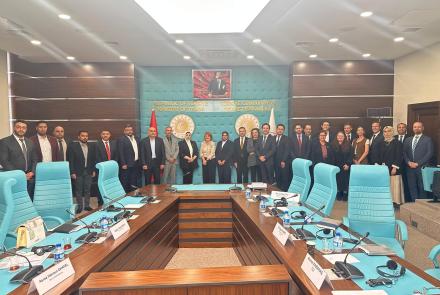The United Nations global border crossing facilitation solution
Anyone who has ever traveled on European roads will recognize the familiar blue and white TIR plate, borne by thousands of trucks and semi-trailers using the TIR customs transit system. For the driver, the transport operator, and the shipper, this plate stands for fast and efficient international road transport.
The revitalization of the economies in Europe following the Second World War was at the origin of the TIR transit system, under the auspices of the United Nations Economic Commission for Europe (UNECE). The first TIR Agreement was concluded in 1949 (Denmark, France, Italy, Switzerland, Norway, and the United Kingdom of Great Britain and Northern Ireland[1]) and its success led to the establishment in 1959 of the first TIR Convention. The 1959 Convention was replaced by the current Customs Convention on the International Transport of Goods under Cover of TIR Carnets in 1975 (TIR Convention, 1975) which came into force in 1978.
The TIR System is based on 5 essential principles:
- Secure vehicles or containers,
- International chain of guarantee,
- The TIR Carnet,
- Mutual recognition of customs controls and
- Controlled access.
Currently, the system counts 77 Contracting Parties and its implementation involves more than 3 million transport operations annually.
The possible enlargement of TIR to new important countries, such as China, Pakistan, Saudi Arabia can lead to even more global application of the TIR system, both in terms of geographical coverage and number of operations, and may entail positive developments for neighboring countries. For example, the possible accession of China is seen as an opportunity for the acceleration of economic development in Central Asia by making landlocked countries of that region an important transit area, in line with the United Nations 2003 Almaty program of action.

TIR Convention and Contracting Parties
https://gis.unece.org/portal/apps/webappviewer/index.html?id=84a9e2fbf11741a6afaf3c29ffa5f72e
Since its approval in 1975, the TIR Convention has been amended various times in order to keep it up to date and in line with the needs of the road transport industry, turning it into one of the most successful international transport conventions (and in fact the only universal Customs transit system existing). However, over the past decades major political, economic, structural, and technological changes have been taking place, like:
- The EU enlargement and the corresponding expansion of the Community Common Transit system in its computerized form (NCTS) in the EU-27 Member States and in neighboring countries, that used to be the traditional strong-holds of TIR Carnet use;
- The creation of the Commonwealth of Independent States (CIS) and the subsequent establishment of a Customs Union between several ex-USSR republics;
- Various regional transit initiatives which are often designed and implemented under the pretext of the TIR procedure being too costly for transport operators in many less developed countries, in particular in the landlocked countries of Central Asia;
- The fundamental restructuring of the freight transport markets has started, and transport of cargo (maritime transport for a long time already) does no longer uses the same transport mode in order to be traded internationally. Containers and similar intermodal transport units are increasingly used also for land transport. Thus, the owner of the shipment or alternatively a series of individual maritime, air, road, rail and inland water transport operators need to control the transit shipment/cargo and provide a guarantee for proper operation. In addition, multimodal logistics service providers have been growing in importance. The road will increasingly only be used for initial and final haulage which will mainly be domestic. This needs to be taken into account in the design of any future Customs transit system;
- Technological achievements have lead to the increasing use of ICT applications, and more and more governments and international governmental organizations have started to build their e-governance solutions, for example, UNECE has promoted the agreement on e-CMR. National Customs procedures are also increasingly based on IT and will increasingly require advance cargo information before the arrival of goods at the border (to allow for better checking and search). Thus, IT usage will become very soon a "sine qua non" for such systems;
- Customs transit systems are only a small part of the general trade procedures and documentation required both for public and private purposes. They must be integrated or must be at least compatible with these other systems (import and export procedures, counterfeiting, sanitary, phytosanitary, economic, security controls, banking, etc.) and must be in line with applied global standards;
- The changing and different roles of Customs services in "developed" market economies on the one side where Customs acts as a service provider and facilitator of trade and transport (low Customs duties and taxes) and in "developing" market economies on the other side where Customs acts as a or as the major revenue provider for Governments (imposition of taxes and duties is easier on imported goods than on income and national sales). In these latter countries, Customs transit and import procedures tend to be rather tight. Thus, a really global transit system must address both types of economies or systems;
- Various international, bilateral and national security initiatives attempt to address (and to some extent “monopolize) the issue of security of the global supply chain. However, it is becoming increasingly clear that Customs authorities are not in a position to check each and every loading unit and piece of cargo, because of the low efficiency of such checks and the costs involved. Instead, Customs authorities place more emphasis and responsibility on "authorized", i.e. reliable operators and shippers, thus shifting cargo and security control from Customs (Governments) to the private sector (this may be no longer only the transport operator, but also the shipper or freight forwarder). Customs will focus on checking only electronic documentation and shift to intelligent checking.
All these changes warranted a strategic review of the current TIR system in comparison with alternative solutions and through a better understanding of what the current market demand is, from the perspectives of its different stakeholders such as shippers, logistics and transport operators, and Customs administrations.




